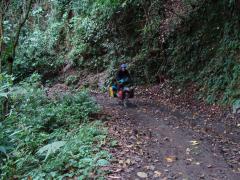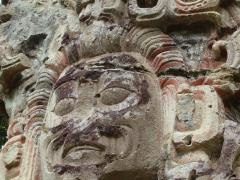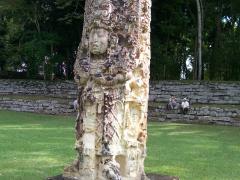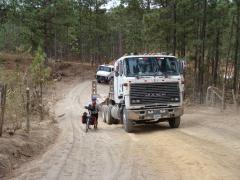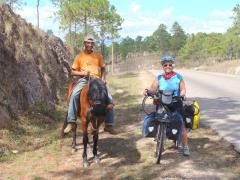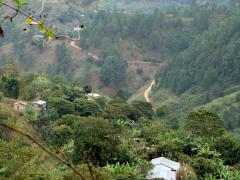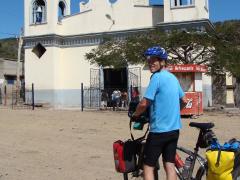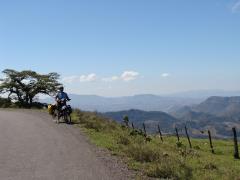Inuvik to Ushuaia
La Tigra National Park Cloud Forest
In Central America there is still some remaining cloud forest. In Honduras we had a chance to visit Parque Nacional ¨La Tigra¨ for a couple of days. We took a 3 hour hike up into the high mountains. We walked along the flower lined path up further into the heavens and into the misty rain forest. The thickness of the clouds increased with each meter we climbed. The visibility dropped down to nearly nothing and the silence of the jungle like mountain forest became louder. Up at 1800 meters there are pine trees, flowering hard wood trees, mosses engulf everything. The parasitic bromeliads grow in the branches and grow with vengeance. We climbed to the 100 meter waterfall before calling it quits. We could have climbed another 6 hours but that day was suppose to be a rest day. It was wonderful having the whole rainforest to ourselves, we did not see another person hiking the old mining trails of ¨La Tigra National Park¨.
What was amazing is that we where only 15 Kilometers from Tugucigalpa, the capital of Honduras. It was just over the ridge another couple of thousand meters higher and then down a couple thousand more. read more here... lee mas aquí... »
Copan Ruins in Honduras
Our first stop in Honduras (and one of the reasons we chose the route we did) was the famous Mayan ruins of Copan. We dragged in at the end of another 3-day stretch of riding these mountains (about the best we've been able to do before resting at least a day). Nancy was sick with some kind of stomach thing and we were both finishing off colds. (All of these ailments are long gone now, thankfully.)
So we weren't at our best the next morning when we went to the ruins. We spent the entire morning there, and hired an English-language guide to explain it all. But we were all the time just feeling like we wanted to be in bed or getting something to eat, which is not what you want when you're at one of the world's most famous and important archaeological sites.
Despite our sorry state, we really appreciated the artistic beauty of the place. We've been to several other Meso-American ruins, and the beauty of the stelae (tall stones that tell a story) and other engravings was just off the chart. Somehow they really developed a much more artistic way of doing all the hieroglyphic writing here.
The environs are beautiful green luxuriant growth, like at Palenque, but the structures are considerably smaller.
Probably the most significant thing we've taken away from Copan was the enormous connectedness of the ancient Mesoamerican world. read more here... lee mas aquí... »
Banking in Honduras
People often ask us how we get money for our daily travels. For the last year and one half we have been able to get money from an ATM using a debit card. While there is not one in every town through out Central America we have been able to plan ahead and get enough money for a week or two or more of travel. Sometimes I feel awkward because I can just go into one of the ATM booths, bypassing the long lines waiting to go into the bank. I just go into one of the private booths, slip my plastic card into a machine and get a couple hundred dollars worth if the local currency.
This is how we have been able get our money until we reached. Gracias, Honduras. We miscalculated our available Lempiras, the Honduran currency, partly due to a hotel clerk in Copan Ruinas going through our bags as we explored the area and removing a few things from our bag including our stashed reserve. We we did not notice the cash being gone until we got low on money. So of course we go looking for an ATM which turned out to be non-existent in the town of Gracias. I went to all three banks to see if I could use my debit card as a Visa and with draw money. It turned out I could at one bank but the system was down and I needed to come back two hours later. I was curious to see I could use my debit card at another bank and since I had a couple of hours to wait anyway I gave it a shot.
What I found at the other bank which is true of all the banks is there is always one or two uniformed guards standing at the entrance with guns that look like sawed-off shotguns. read more here... lee mas aquí... »
Route through Honduras
You may remember our friend Tim Malloch that we met in the north of Mexico, in the Copper Canyon region. He was headed north, and we south, and like all travelers we meet, we pestered him with lots of questions about his route and his favorite places along it. We remembered him telling us that the back roads from Santa Rosa de Copan to La Esperanza were his favorite section in all of Central America. So we set out to follow his route. We suspected, but didn't know, that it would continue the really tough mountainous route that we'd already been struggling with in Guatemala. But we took it, and he was right, it was delightful. We spent several days with nearly no traffic, delightful pine-covered hills, and interesting people tucked back in remote valleys. We passed by little roof-tile making operations (apparently the clay is good in this area) and climbed through some of the most remote areas we've been in since northern Mexico. In one town we found no available hotel or "hospedaje" (cheap hospitality) but the mayor happily opened up the municipal offices and settled us in the community meeting room. We had all the comforts of life including a bathroom and a cold shower (which was one of the lesser cold showers we've had). read more here... lee mas aquí... »
Crossed into Nicaragua today
We crossed into Nicaragua today - our 6th country on the trip. We had no problems at all, and all the officials were very friendly. Once again, we even got a fair rate of exchange from the moneychanger. We now have Nicaraguan Córdobas, which about about 18 to the dollar, instead of Honduran Lempiras, which are about 19 to the dollar.
Impressions of Nicaragua
What a delightful surprise Nicaragua has been to ride in. From the moment we crossed the border from Honduras into Nicaragua, biking through a country which is the poorest in Central America has been a great experience. Yes we see some very sad sights, houses made of mostly discarded scraps of plastic, lumber, tin and natural products, children without shoes, communities with no electricity, shared wells and old people begging for money. But mostly we find a land with a many different aspects.
We ride up through dry mountain regions on remote dirt roads and everyone tells us we will have no troubles, that we´ll have no security problems because we are outside the urban areas. What we have found is whole communities come out to see the Gringos on bikes riding through their neighborhood, children yelling out hello, good afternoon or by practicing the few words of English they know. Many children near the border would ask for money, the only word they knew. Randy gave a few of the children in Honduras a lecture about asking for money and how it was impolite not to say hello as a friend, but none of the children in Nicaragua have been like that. We learn a lot as we ride through the different parts of Central America.
Some of the steep mountain areas cause us to rest more and to walk our bikes up the steep grades. We have had a chance to walk with more people or ride along a campesino on a horse. read more here... lee mas aquí... »
The Valley near San Marcos outside of Esteli
We woke up rather late on Wednesday morning (6:00am) and decided we did have enough energy to take on the 40 mile tough ride from Estelí to Jinotega, all on dirt. We saw maybe 10 to 20 vehicles on the remote Nicaragua back road which were mostly buses serving the local communities, The landscape was mostly dry desert and rolling hills; other areas along the way were highly productive river valleys were tobacco, onions, cabbage, potatoes where being harvested.
We stopped at a small tienda in the middle of the trip to purchase a cold drink. There we meet many local residents including Sarah, a Peace Corps volunteer, who lives in a rented brick house across from the store. We knocked on her door to say hello and a small petite dark haired, young 20ish female came out and greeted us. She was the famous local gringa. We spent sometime with Sarita learning about her life in the middle of rural Nicaragua as a Peace Corp volunteer.
The house Sarah lives in is owned by a young man who has left to work in the United States so she rents it from his family. The house has electricity which was installed in the area a year ago by the government of Nicaragua. She does not have running water but gets water from the neighbor´s hand operated water pump. She washes her clothes river nearby. Since Sarah does not have a refrigerator she stores perishables in the neighbors refrigerator, the rich ones in the neighborhood. read more here... lee mas aquí... »
The ride from San Marcos to Jinotega
Let me take a moment and tell you about one of the villages we rode through on the way from Estelí to Jinotega, Nicaragua this week. San Marcos is a strange little village where everything has been built around a lone church. The houses in the village form a huge empty dirt circular void around the church with nothing in between. It reminded me of an old ghost town but there was people in front of every house, just sitting and watching the strange gringos ride through their village.
It was around high noon as we rode in. In the bell tower were two young boys ringing the church bell, calling to everyone that the funeral service was about to begin. The only restaurant closed up just seconds before we rode up (probably because of the funeral). Everyone was strolling toward the church and those that were not just sat and stared at us, hungry we rode on to another part of the village that had promise for lunch time nourishment and knowing that we had some hard climbs ahead. With just a small printed sign above a door, I stopped to ask where we could find something to eat. An older man rushed off to find his aging wife. Bingo, there was some food on the stove which they would gladly serve us. We still do not know if this was an official place that served food but they did for us. They were first concerned that we would not like the food they had to offer- beans, squash cooked in the beans and corn tortillas and some kind of milky fruit like drink. We assured them we eat everything, several times. read more here... lee mas aquí... »
The saint of San Rafael
On the struggle out of the valley of San Marcos, a truck stopped and offered us a lift. It was driven by an Italian Catholic priest in traditional robes and two sisters with similar brown habits. They smiled so nicely as they told me about their lovely town of San Rafael and their special church. They encouraged me to visit San Rafael which I did the next day.
I took a bus out to San Rafael and did agree that is was a wonderful village. I got a private tour of Tepeac by the groundskeeper who had great love for this special place. According to an article published in the Nica News 21 (March 1999) “The most outstanding figure in the history of San Rafael is the Italian priest, Father Odorico D'Andrea. From his arrival in 1953 to his death in 1996, Father Odorico achieved virtual sainthood among the people of San Rafael and the surrounding communities. His image, a smiling, warm, obviously kind man in plain brown robes, can be seen in nearly every home, business and vehicle in the town. "It's so sad," said one community member, "that you weren't here to know him." Among his achievements are a formidable health clinic, a library, several neighborhoods for the poor, and the beautifying of the church.
The latter feat is truly impressive. Pastel-colored windows admit a calming light in which to view the many bright murals, bas-reliefs and shrines. read more here... lee mas aquí... »
Guatemala South to Nicaragua Pictures
Here is a slideshow of the pictures from our re-start in Guatemala at the beginning of 2008 to the middle of Nicaragua. You can view all the pictures in full size and with their captions on flickr and see the show at flickr here. You can see all our photos at flickr.com/photos/hobobiker.


